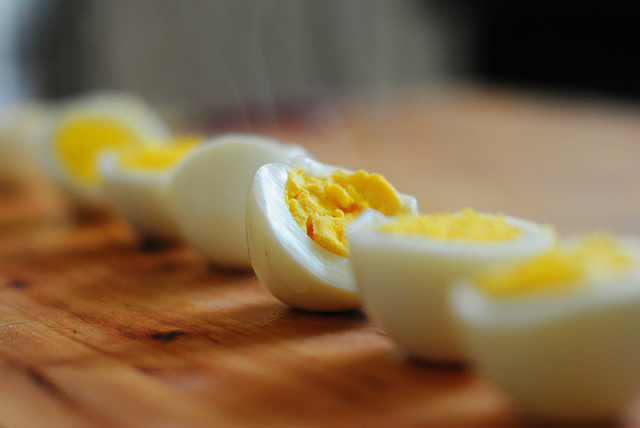 Photo via Flickr member pixellou
Photo via Flickr member pixellou
What is a hard boiled egg?
A hard boiled egg is an egg which is boiled, with a full, unbroken shell. The egg is boiled long enough for both the egg white and egg yolk to solidify. Sometimes, as a variation, the egg is boiled to near solidity, but then left in the hot water to finish the cooking process in the residual heat. In contrast to a hard boiled egg, a soft boiled egg will have a yolk that remains quite soft and a white that is not as firm as its hard boiled-counterpart.
As a bit of fun trivia, what we today call “egg timers” were given the name because of their common usage in timing the boiling of eggs.
What makes a good hard boiled egg?

Photo via Flickr member neeta_lind
A good hard boiled egg is not over or under-done; it is just right. The shell peels off easily, without shards of shell sticking to the egg. The white is firm yet yielding, smooth and silky and tender in texture. It is cooked so that the yolk has become solid, but it remains gently firm, not rubbery or excessively gritty in texture.
How on earth do you attain that perfect balance? With science, and a little patience. It’s not difficult to master the art of perfectly boiling eggs; these tips will help ensure future success.
Cooking hard boiled eggs
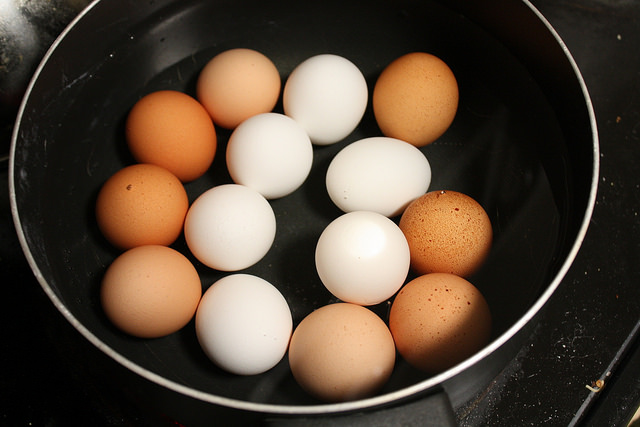 Photo via Flickr member andrewtoskin
Photo via Flickr member andrewtoskin
What happens when you boil an egg is that the proteins, which compose about 10% of the egg white, are going to solidify in the heat, which will break down the amino acids which will allow the protein to react. They will begin to form bonds which will first turn the egg gelatinous, then opaque and solid. The issue is that if there is too much reaction, the proteins will form too many bonds and squeeze out too much water, which will leave the egg white rubbery in texture. To make sure that you don’t end up with rubbery or runny eggs, it’s important that they are cooked through.
Choosing the best egg for the job
While you might have an idea that the more recently an egg was laid, the better, it’s not true for hard boiled eggs. The more recently it was laid, the more likely it is to stick to the shell once cooked. According to Exploratorium.edu, the reason is that newer eggs are more acidic; as an egg sits, carbon dioxide will leak through the pores in the shell, making the egg white less acidic and therefore less likely to stick to the shell. Your eggs don’t have to be aged like wine; a week or two will do, if they are very fresh. Likely, if you are buying eggs from a supermarket, they are already a week “old” or more.
Temperature matters
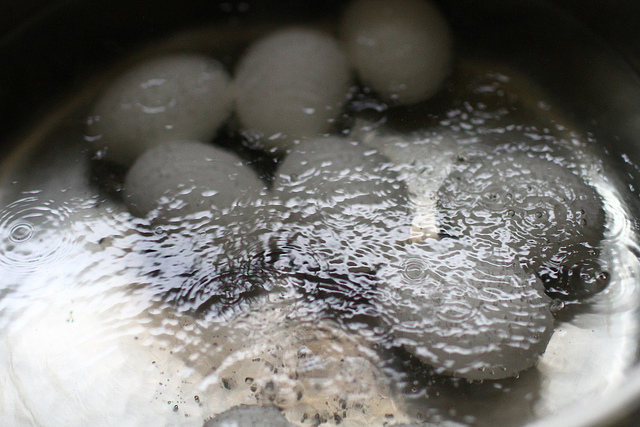 Photo via Flickr member chriswaits
Photo via Flickr member chriswaits
There are two primary schools of thought with the water temperature for boiling eggs. One is that you start with cold water, which you heat with the egg submerged; the other is that you boil water, into which you drop the egg. Let’s take a few moments to discuss the advantages and disadvantages of both methods.
Cold water method
Basic idea: You put the egg in water while it is still cold, and then turn on the heat.
Advantages: When you start with cold water, you heat the egg slowly and gradually. This “slow but steady” method can be easier to keep the egg whites from becoming rubbery.
Disadvantages: This method can take a long time, and it can be hard to monitor how far along it is in the cooking process. Plus, the slow cooked eggs can tend to bond with the membrane on the exterior of an egg, making it hard to remove the shell.
Hot water method
Basic idea: You heat the water to the boiling point, and then drop in your egg.
Advantages: This method yields a faster cook time.
Disadvantages: It can be harder to pinpoint doneness in your eggs. The exterior may set too fast in the hot water, leaving you with a yolk that is still runny. Yet to cook the yolk through, your egg white may become rubbery.
Personally, I prefer the cold water method because it allows more control over cooking the eggs fully; I pair this with “shocking” the eggs by placing them in ice water after they are done cooking. More detail can be found below.
Alternative methods
Here are a few easy alternatives to the above basic methods.
Start the heat high, then go low
Drop your eggs into boiling water, let them cook for 30 seconds, then reduce the heat to a low simmer to finish them off, for about 10 to 11 more minutes, followed by “shocking” them in ice water. The idea is this: the hot temperature will make the inside shrink away from the shell, for easy peeling, and reducing the temperature will ensure that the egg white doesn’t cook too thoroughly, and will allow the inside to heat more gradually.
Steam your eggs
Place your eggs above simmering water so that they can steam their way to cooked perfection. According to Alton Brown, the timing you should adhere by is 12 minutes of steaming followed by “shocking” them in ice water for the perfect hard boiled egg. This method is nice in that there’s less chance of egg breakage, and you don’t have to worry about removing eggs from hot water.
Other cooking notes
 Photo via Flickr member dbgg
Photo via Flickr member dbgg
How to avoid dimples
Eggs have a space that contains just air. When boiled, this air eventually escapes through pores in the shell, but usually not before the egg white has set. This results in a slightly flattened “dimple” at one end. One method which is largely accepted to avoid the “dreaded dimple” is to prick the larger end of the egg with a pin before putting it in the water. This allows that air to escape, and ideally helps avoid the dimple.
Of course, if the dimple doesn’t bug you, or if you’re using these eggs for a dish such as egg salad, where their perfect form isn’t important, just proceed without any pinpricking!
Shocking your eggs
“Shocking” is when you remove your eggs from the hot water and place them immediately into cold or ice water. Shocking immediately stops the cooking process, as opposed to either leaving them in the hot water or removing and leaving in the shells, where the cooking process will continue for a short time even after off-heat. Shocking is a good choice because not only does it keep your eggs from overcooking, but it can also make them easier to remove from the shell.
Peeling hard boiled eggs
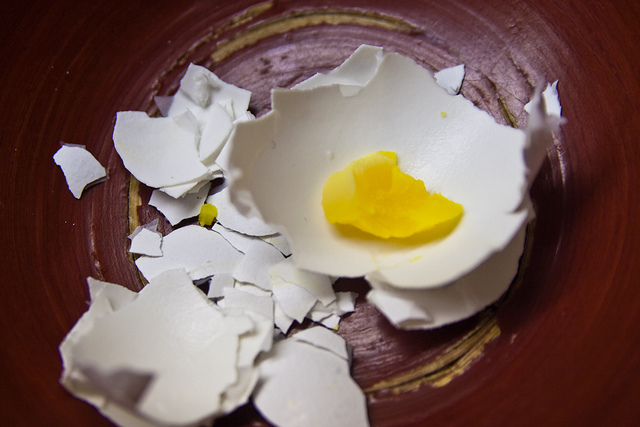 Photo via Flickr member stevendepolo
Photo via Flickr member stevendepolo
How long do you wait before peeling?
The eggs will peel much more cleanly and easily if chilled first. Keeping them in an ice bath for 20 minutes, or refrigerating for several hours, will help them be at their prime for peeling, allowing the egg to shrink a little within its shell and separate further from it.
How to peel hard boiled eggs
Here are some easy ways to peel:
- Crack the egg all over with a spoon, as if it were a creme brulee. Then, under running water with a strainer beneath, peel the egg by hand, allowing the shell to fall into the strainer.
- Gently (gently!) roll the egg on a counter surface to loosen the shell, and peel away. Once again, peeling under running water is a great way to reduce mess.
Storing hard boiled eggs
- Store hard boiled eggs in the refrigerator for up to one week.
- Hard boiled eggs will not keep at room temperature for more than a few hours. It is necessary to refrigerate them.
- Do not peel your eggs until you are ready to eat or use in a recipe.
Simple recipe for hard boiled eggs
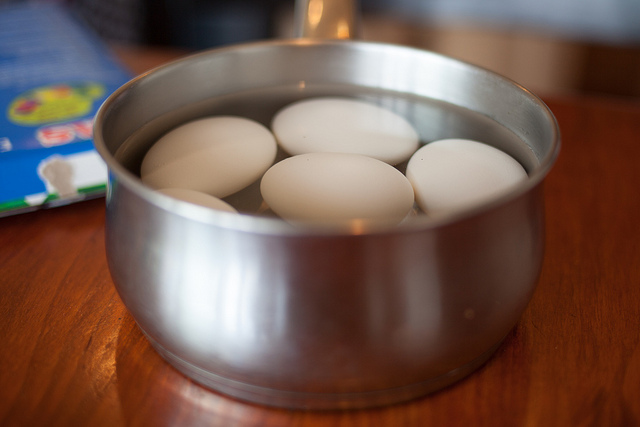 Photo via Flickr member mbiddulph
Photo via Flickr member mbiddulph
- Place the eggs in a saucepan, in a single layer with some room to move. Add enough water to cover the eggs by 1 inch.
- Apply high heat to the burner, and heat to just boiling. Once a boil is reached, remove from the burner and cover the pan.
- Let the eggs stand in the hot water for about 10-12 minutes (on the lower end for smaller eggs, longer for jumbo or extra large eggs).
- Transfer the eggs into a bowl of ice water. Once cooled, remove from the ice water and refrigerate until you’re ready to eat.


